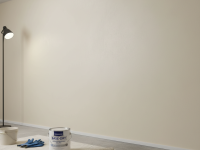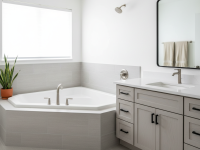Hey there, fellow homeowner! Have you ever walked into a room and just felt… sticky? Or maybe you’ve noticed a faint, musty smell, or even condensation on your windows? Chances are, your home’s humidity might be a little off-kilter. We all want a comfortable, healthy living space, but often, we jump straight to thinking about expensive gadgets like dehumidifiers. What if I told you there are wonderfully simple, natural ways to tackle this without plugging in another appliance?
I’ve been there. For years, I struggled with a perpetually damp bathroom and a living room that just felt heavy in the summer. I considered buying a dehumidifier, but then I started looking into more eco-friendly and budget-friendly alternatives. And honestly, the results have been fantastic! Balancing your home’s humidity naturally isn’t just about saving money; it’s about creating a more harmonious, healthy environment for you and your family. Let’s dive into some of the best tricks I’ve learned and implemented.
Ventilation: Your First Line of Defense
This might sound ridiculously simple, but proper ventilation is often overlooked. It’s the most powerful, natural tool you have for controlling indoor humidity.
- Open Those Windows! Seriously, even for just 10-15 minutes a day. Cross-ventilation (opening windows on opposite sides of your home) works wonders to cycle out stale, moist air and bring in fresher, drier air (weather permitting, of course!). I make it a ritual every morning, especially in rooms that tend to get stuffy.
- Exhaust Fans Aren’t Just for Show: If you have exhaust fans in your bathroom or kitchen, use them! Turn on your bathroom fan during and for at least 20-30 minutes after a shower or bath. In the kitchen, use your range hood while cooking, especially when boiling water or simmering dishes. This pulls moisture-laden air directly outside before it can spread throughout your home. I used to forget to turn mine on after a shower, and the difference is truly noticeable in how quickly the mirror clears and the room dries out.
- Strategic Door Usage: During a hot shower or when cooking, keep the doors to those rooms closed to contain the humidity. Once you’re done and the exhaust fan is ruing, you can open them up to allow for air circulation.
Harnessing the Power of Natural Absorbents
Nature has its own little moisture magnets! These simple, inexpensive materials can make a surprising difference in smaller, enclosed spaces.
- Rock Salt (Sodium Chloride): Yes, the same stuff you put on your food! Rock salt is a natural desiccant, meaning it absorbs moisture from the air. You can place bowls of rock salt in damp areas like basements, closets, or even under sinks. Just remember to replace it when it starts to clump up or looks excessively wet. I once placed a bowl in my rather damp laundry room, and I was genuinely surprised by how much water it collected over a week!
- Baking Soda: Another household hero! While not as powerful as rock salt for large areas, baking soda is fantastic for absorbing odors and a bit of moisture in smaller, enclosed spaces. Think shoe closets, refrigerators, or small cupboards. Just place an open box or a bowl of it where needed.
- Activated Charcoal: Beyond its use in water filters, activated charcoal is a fantastic natural odor and moisture absorber. You can find it in bags or canisters specifically designed for this purpose. I hang charcoal bags in my wardrobe and near my entryway, and it really helps keep things fresh and dry.
- Silica Gel Packets: Those little packets that come with new shoes or electronics? Don’t throw them away! They’re excellent for absorbing moisture in very small, enclosed spaces like storage bins, camera bags, or even toolboxes to prevent rust.
Mindful Daily Habits: Small Changes, Big Impact
Our everyday routines contribute a lot to indoor humidity. Adjusting these habits can make a significant difference without any extra effort once they become second nature.
- Laundry Day Wisdom: If you live in a climate where you can dry clothes outdoors, do it! The sun and fresh air are the best natural dryers. If air-drying indoors, try to do it in a well-ventilated area or near an open window. Avoid air-drying large loads in small, unventilated rooms, as all that evaporating water will just go into your home’s air. I learned this the hard way when my bedroom started feeling like a sauna after drying a big load of towels in it.
- Cooler, Shorter Showers: Hot, steamy showers are lovely, but they pump a lot of moisture into your air. Try to take slightly cooler and shorter showers. Every little bit helps.
- Cover Pots While Cooking: When boiling water or simmering soups, simply placing a lid on your pots can significantly reduce the amount of steam escaping into your kitchen air. It also helps food cook faster, saving energy!
- Wipe Down Wet Surfaces: After showering, quickly wipe down shower walls and the tub. After cooking, wipe down countertops and sinks. Removing standing water immediately prevents it from evaporating into the air.
- Bring Plants Indoors (Strategically): Some plants are known to absorb moisture from the air, acting as natural dehumidifiers. Think of plants like Boston Ferns, Peace Lilies, English Ivy, or Spider Plants. However, be careful not to overwater them, as excess water in the soil can contribute to humidity. I have a beautiful Boston Fern in my living room, and it looks great while doing a little bit of humidity work.
Addressing Exterior and Interior Moisture Sources
Sometimes, humidity issues stem from problems outside or within the structure of your home. Addressing these can be key.
- Check for Leaks: A leaky faucet, pipe, or roof can introduce a constant source of moisture. Regularly inspect under sinks, around toilets, and check your ceiling for any signs of water damage. Fixing leaks promptly is crucial not just for humidity control, but for preventing structural damage and mold.
- Ensure Proper Drainage Outside: Make sure rainwater drains away from your home’s foundation. Clean your gutters regularly to prevent water from pooling. If water pools near your house, it can seep into your basement or crawl space, contributing to indoor humidity.
- Improve Insulation and Seal Gaps: While this can be a bigger project, properly insulating your home and sealing cracks around windows and doors prevents humid air from seeping in (or out, if you’re trying to retain humidity). Simple weatherstripping or caulk can make a big difference.
When the Air is Too Dry: Naturally Increasing Humidity
While often we’re battling excess moisture, in very dry climates or during winter months with heating on, homes can become too dry. Natural ways to add moisture include:
- Humidifying Plants: Plants like the Areca Palm or Ficus elastica (Rubber Plant) release moisture through transpiration.
- Bowls of Water: Place bowls of water near heat sources (but safely, away from direct contact) to allow for slow evaporation. You can add decorative stones or essential oils too!
- Indoor Laundry Drying: In extremely dry conditions, air-drying laundry indoors can actually be beneficial, adding much-needed moisture to the air.
- Cooking on the Stovetop: Boiling water for pasta or making soups without lids can add moisture back into dry air.
Conclusion: Embrace a Naturally Balanced Home
You see? Achieving a comfortable and healthy humidity level in your home doesn’t have to mean resorting to expensive, energy-guzzling machines. By simply being more mindful of your daily habits, utilizing natural absorbents, and ensuring proper ventilation, you can create a naturally balanced environment that feels fresh, clean, and inviting.
I genuinely believe that these simple, natural approaches not only improve the air quality but also make you more coected to your living space. Give a few of these tips a try, and I think you’ll be pleasantly surprised by how much of a difference they make. Here’s to breathing easier in your naturally balanced home!




